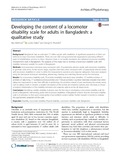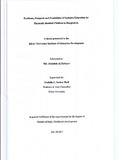| dc.contributor.author | Mahmud, Ilias | |
| dc.contributor.author | Clarke, Lynda | |
| dc.contributor.author | Ploubidis, George B. | |
| dc.date.accessioned | 2022-03-06T05:53:46Z | |
| dc.date.available | 2022-03-06T05:53:46Z | |
| dc.date.copyright | 2017 | |
| dc.date.issued | 2017-06-06 | |
| dc.identifier.citation | Mahmud, I., Clarke, L., & Ploubidis, G. B. (2017). Socio-demographic determinants of the severity of locomotor disability among adults in Bangladesh: A cross-sectional study, December 2010-February 2011. Archives of Public Health, 75(1) doi:10.1186/s13690-017-0217-5 | en_US |
| dc.identifier.uri | http://hdl.handle.net/10361/16399 | |
| dc.description | This article was published in the Archives of Physiotherapy [© The Author(s). 2017 Open Access This article is distributed under the terms of the Creative Commons Attribution 4.0 International License (http://creativecommons.org/licenses/by/4.0/) ] and the definite version is available at : https://doi.org/10.1186/s40945-017-0035-7 The Journal's website is at: https://archivesphysiotherapy.biomedcentral.com/articles/10.1186/s40945-017-0035-7#citeas | en_US |
| dc.description.abstract | Abstract
Background: Bangladesh has an estimated 17 million adults with disabilities. A significant proportion of them are
believed to have locomotor disabilities. There are over 300 non-governmental organizations providing different
types of rehabilitation services to them. However, there is no locally developed and validated locomotor disability
measurement scale in Bangladesh. The purpose of this study was to develop a locomotor disability scale with
disability indicators suitable for adults in Bangladesh.
Methods: Semi-structured interviews were conducted with 25 purposively selected adults with locomotor disabilities
to generate scale items. At the second stage, cognitive interviews were conducted with 12 purposively selected adults
with locomotor disabilities in order to refine the measurement questions and response categories. Data were analysed
using the framework technique- identifying, abstracting, charting and matching themes across the interviews.
Results: For a locomotor disability scale, 70 activities (disability indicators) were identified: 37 mobility activities, 9
activities of daily living, 17 work/productivity activities and 7 leisure activities. Cognitive interviews revealed that when
asking the respondents to rate their difficulty in performing the activities, instead of just mentioning the activity name,
such as taking a bath or shower, a detailed description of the activity and response options were necessary to ensure
consistent interpretation of the disability indicators and response options across all respondents.
Conclusions: Identifying suitable disability indicators was the first step in developing a locomotor disability scale for
adults in Bangladesh. Interviewing adults with locomotor disabilities in Bangladesh ensured that the locomotor disability
scale is of relevance to them and consequently it has excellent content validity. Further research is needed to evaluate
the psychometric properties of this scale. | en_US |
| dc.language.iso | en_US | en_US |
| dc.publisher | BMC | en_US |
| dc.relation.uri | https://archivesphysiotherapy.biomedcentral.com/articles/10.1186/s40945-017-0035-7#citeas | |
| dc.subject | Disability | en_US |
| dc.subject | Locomotor disability | en_US |
| dc.subject | Physical disability | en_US |
| dc.subject | Locomotor disability scale | en_US |
| dc.subject | Bangladesh | en_US |
| dc.title | Developing the content of a locomotor disability scale for adults in Bangladesh: A qualitative study | en_US |
| dc.type | Journal Article | en_US |
| dc.description.version | Published | |
| dc.contributor.department | Brac James P. Grant School of Public Health | |
| dc.identifier.doi | https://doi.org/10.1186/s40945-017-0035-7 | |
| dc.relation.journal | Archives of Physiotherapy | |




